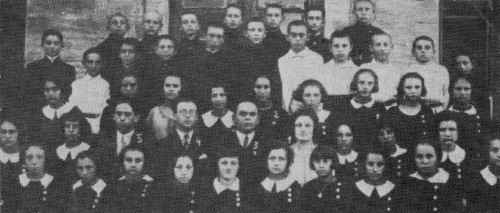 |
In the center, from right to left: teachers
- Bronstein;
- Unknown
- Principal Gedalya Rosenthal;
- Yeshayahu Vinitsky;
- Unknown
|
|
[Page 298]
Translated by Ala Gamulka
Eliezer Shulman, whose article is published above, was a special personality. He brought good publicity and honor to the Jewish community of Tarutino. He was liberated from Soviet exile in 1974 after dozens of years and arrived in Czernowitz with his wife. He was an expert in railroads and iron tracks and served the Soviets in this capacity in the Gulag. At the same time, all during his exile, he continued to do research on the Bible.
When the Shulmans applied to make Aliyah he was immediately fired from his job. His wife, a doctor, was sent to work as a porter. After Shulman sent a letter to Israel describing the attitude of the Soviets towards his wife, they were both given permission to leave.
When Shulman arrived in Israel he was welcomed enthusiastically by the President. He was interviewed by various newspapers and soon his research was published. He had dedicated much time and effort to the research while he was in exile.
In “Maariv” of 26.08.1981 there is an article by Yaakov Ha'elion titled “The Bible Researcher from Siberia”. Here are some quotes from it:
Recently the Defence Ministry published his research thesis entitled “Order of the Chronicles in the Pentateuch”. It is an outstanding book that was born in the Gulag where God is a disreputable name that does not exist. He was determined to personally teach the Bible to his daughters.
One of his daughters asked: did Noah, who was saved by being in the ark, abandon his father and grandfather? This is a moral question that requires a clear answer. This question pulled him to do his research on the Bible. His tools were a deep personal knowledge, a pocket calculator, Tanach volumes and commentaries he obtained in secret in the permanent snow fields. He eventually was able to tell his daughter that Noah did not abandon his elders, but that they had died before the flood. During his research he found more amazing facts such as that Abraham was able to see his grandsons Jacob and Esau since he lived an additional 15 years after their birth.
His work also includes an exact family tree of all figures in the Torah. An interesting fact is that although the State of Israel was declared in 1948, this was also the year BCE when God gave Abraham Canaan. There were many special details that he found, but he was most proud of the table called “Declaring the Covenant on the Land”. In it he quotes specific times when God promised Avraham Isaac and Jacob the rights to Eretz Israel.
Naomi Shemer has always been aware of Shulman. She knows that in Siberia he “worked” on the song “Four Brothers” and made them to be four brothers in the Soviet Union. He showed her his research and she wrote: “This is a document with depth, clear thinking and strong diligence”. Rabbis read his work and are amazed by it. The chief Rabbi of the Air Force is charmed by the “personal dedication and perseverance needed to complete this holy work”. Issar Frenkel, chief Rabbi of Tel Aviv describes the research as “giant work”. The President of Israel, Yitzhak Navon, encouraged him to publish his work and said it was “miraculous”. Everyone saw this work as something that could open eyes and was easy to digest because he simplified details.
Eliezer Shulman– the immigrant who was quickly absorbed in the country two weeks after his arrival – feels like a complete Israeli citizen.
[Page 299]
|
|
In the center, from right to left: teachers
|
|
|
| Female students of Tarbut High School in Tarutyno with their teacher Mikhael Kovlenov (1922)
Student Khemda Ben Israel (Sheindl Katz) describes teacher Kovlenov as “a nice man, but quick to get angry and considered mean. After four years with us it was difficult to say goodbye. Only then did we discover his goodness. He was tearful. We used to call him Kovlenchik or Mishika.”
Standing: R. to L. Feiga Shchiglova, Khaya Umansky, Riva Shtilman, Khedva Ben Israel(Sheindl Katz), Niusia Reikhman |
[Page 300]
|
|
A letter from Hovevei Zion of Tarutino to Hovevei Zion in Warsaw |
[Page 301]
|
|
|
|
[Page 302]
|
|
|
|
[Page 303]
|
|
Middle row from left to right: Kalman Cooperman, Leibl Schwartzman, Sioma Kogan, Haim Trachtman, Ilusha Lerner, Leah Lainzon, Etel Katz, M. Baratz Seated bottom row from left to right: Hannah Malamud, Rozalia Zuckerman, Leah Averbuch, Raizel Schwartz, teacher Voskovoinik, Sioma Feisher, Sonia Friedman, Dolia Shulman, Nehama Zaltshendler, Rosa Zuckerman, Deutch, Haya Averbuch |
|
|
of the Tarbut High School in Tarutino in 1931 Row 2 seated from left to right: Ida Brilliant, Fira Gnessin, teacher Volkovitz, Hannah Kanner, and Rosa Kanner Standing: Nahman Shulman, Feiga Katz |
[Page 304]
|
|
|
|
JewishGen, Inc. makes no representations regarding the accuracy of
the translation. The reader may wish to refer to the original material
for verification.
JewishGen is not responsible for inaccuracies or omissions in the original work and cannot rewrite or edit the text to correct inaccuracies and/or omissions.
Our mission is to produce a translation of the original work and we cannot verify the accuracy of statements or alter facts cited.
 Bilhorod-Dnistrovs'kyy (Akkerman), Ukraine
Bilhorod-Dnistrovs'kyy (Akkerman), Ukraine
 Yizkor Book Project
Yizkor Book Project
 JewishGen Home Page
JewishGen Home Page
Copyright © 1999-2026 by JewishGen, Inc.
Updated 15 Nov 2016 by LA